BATTLE OF BRITAIN: MONTHS OF TERROR BEGIN
London, England • July 10, 1940
On this date in 1940, less than one month after France’s humiliating capitulation to Nazi Germany and just 10 days after the Germans had seized Great Britain’s Channel Islands of Jersey and Guernsey off France’s Brittany coast, Luftwaffe aircraft based in occupied France began a relentless aerial campaign targeting the lone European holdout against the German juggernaut. Adolf Hitler’s aim in the four-month Battle of Britain (July 10 to October 31, 1940) was to destroy the Royal Air Force (RAF) Fighter Command, ravage British radar defenses, and generally prepare the way for Operation Sea Lion (Unternehmen Seeloewe), the Wehrmacht’s amphibious and airborne invasion of England. Before the Battle of Britain ended, hundreds of British and German airmen and thousands of British civilians would be dead or injured.
A German invasion force projected at 20 divisions strong was assembling in ports on the continent even as Luftwaffe fighters and bombers began their relentless aerial campaign of destruction—which Air Marshal Hermann Goering assured Hitler would be successful in a matter of weeks. The RAF disabused both men of that notion even as it took a terrible beating: In just over a week of close-in combat, the RAF lost 106 pilots and 208 fighter aircraft, with no hope of replacing the lost planes quickly. Against the RAF’s 570 Supermarine Spitfires and Hawker Hurricanes in Southeast England, the Luftwaffe deployed an armada of nearly 3,200 aircraft consisting of hundreds of Messerschmitt single-seat Bf 109s and two- and three-seat Bf 110 fighter-bombers along with hundreds Heinkel He 111 and Dornier Do 17 twin-engine bombers.
On the night of August 25, 1940, the RAF bombed two Berlin districts, Kreuzberg and Wedding, shocking Hitler, his military coterie, and the nation. (Goering had assured Hitler that an air raid on the Nazi capital was out of the question. Germans, always enjoying a rich irony, started calling air raid sirens “Meyer’s [or Meier’s] trumpets” after learning of Goering’s boast that people could call him “Meyer” [a common surname in Germany] instead of by his real name should bombs ever fall on German cities.) Out of pique Hitler ordered Goering’s Luftwaffe to retaliate—to concentrate on bombing English cities. Energetic and devastating as it was, this was a major tactical error on Hitler’s part because it meant RAF airfields, aircraft, hangars, and barracks were no longer his main target, and as a consequence it allowed Britain’s military to rebuild and strengthen its defenses. Between the start of the German “Blitz” in September 1940 and its end in May 1941, it befell the general population to endure the harsh reality of German air raids, air raid sirens, sudden death, raging fires, and collapsing industrial, business, and apartment structures.
The worst destruction the Luftwaffe inflicted occurred on September 15, 1940, now known as Battle of Britain Day, the day Goering had hoped to eliminate the RAF from English skies. German bombers pounded the British capital day and night, as well as the ports of Bristol, Cardiff, Liverpool, and the manufacturing center of Manchester. Nearly 200 RAF fighter planes tangled with enemy aircraft over London, while 300 fighters defended the airspace over southern England. The Luftwaffe lost 56 aircraft (bombers and fighters), with 2 missing, to the RAF’s 29. The hard-fought Battle of Britain was somewhat of a draw, though, the British losing approximately 1,643 aircraft to the Germans’ 1,686. (The Luftwaffe seriously overestimated the number of British kills, which led the Germans into thinking RAF Fighter Command was on its last legs, or nearly so.) By the time the murderous follow-on Blitz ended without a German victory in mid-1941—actually, it was Germany’s first defeat in the war—Sea Lion had been replaced by another ambitious yet equally futile operation in the planning stages, Operation Barbarossa, the German invasion and occupation of European Russia. Hitler would live to regret his decision that the Soviet Union would be an easier opponent than Great Britain to defeat.
![]()
The Blitz, September 7, 1940, to May 21, 1941: Hitler’s Follow-On Campaign to the Failed Battle of Britain
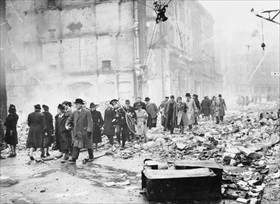 | 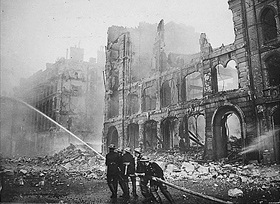 |
Left: Office workers make their way through a debris field as they go to work after a heavy air raid on London. During the eight-month Blitz, London suffered 71 major air raids—major meaning at least 100 tons of bombs were dropped. Other metropolitan areas experienced at least 56 major air raids. All told, the Blitz cost around 41,000 lives and may have injured another 139,000.
![]()
Right: Firefighters put out a blaze in London after a 1941 air raid. The Luftwaffe dropped around 45,000 short tons of bombs during the Blitz, disrupting production and transport, reducing food supplies, and shaking British morale. However, the Germans’ hoped-for effect from their aerial campaign never materialized. Britain was never moved to negotiate an armistice, nor was war production decisively weakened. Material U.S. assistance more than made up for temporary war and food production shortfalls.
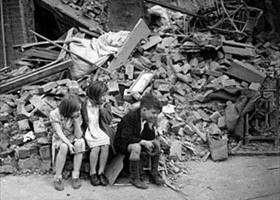 | 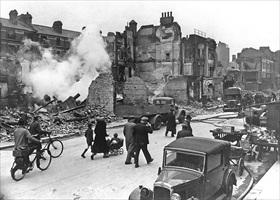 |
Left: Children of a London suburb, made homeless by the random bombs of Luftwaffe night raiders, wait outside the wreckage of what was their home, September 1940.
![]()
Right: A street of ruined houses in London. Though militarily ineffective, the Blitz caused enormous damage to Britain’s housing stock. Many sites of bombed buildings, when cleared of rubble, were cultivated to grow vegetables to ease wartime food shortages and were known as “victory gardens.”
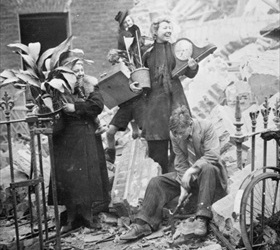 | 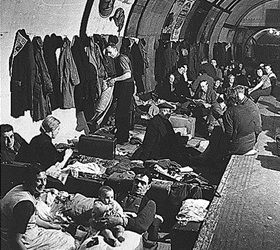 |
Left: Women salvage prized possessions from their bombed house, including plants and a clock.
![]()
Right: A London Underground station serves as an air raid shelter during the Blitz, an all-to-common scene.
The Battle of Britain, July 10 to October 31, 1940. Produced by U.S. War Department. Part of Frank Capra’s “Why We Fight” Series
![]()

 History buffs, there is good news! The Daily Chronicles of World War II is now available as an ebook for $4.99 on Amazon.com. Containing a year’s worth of dated entries from this website, the ebook brings the story of this tumultuous era to life in a compelling, authoritative, and succinct manner. Featuring inventive navigation aids, the ebook enables readers to instantly move forward or backward by month and date to different dated entries. Simple and elegant! Click
History buffs, there is good news! The Daily Chronicles of World War II is now available as an ebook for $4.99 on Amazon.com. Containing a year’s worth of dated entries from this website, the ebook brings the story of this tumultuous era to life in a compelling, authoritative, and succinct manner. Featuring inventive navigation aids, the ebook enables readers to instantly move forward or backward by month and date to different dated entries. Simple and elegant! Click 











